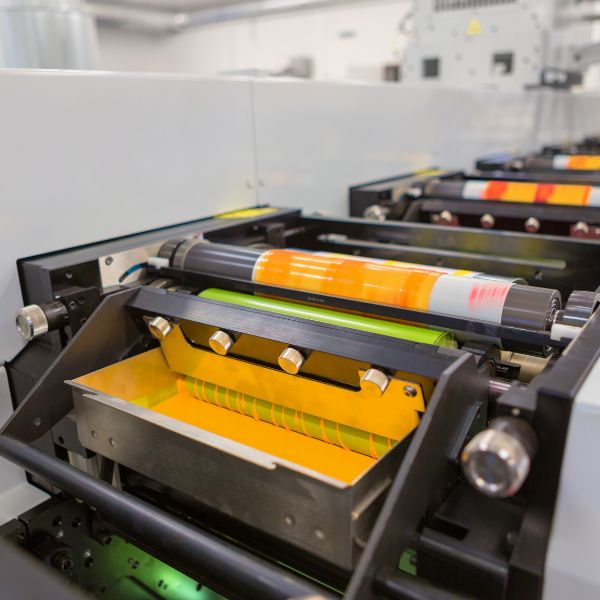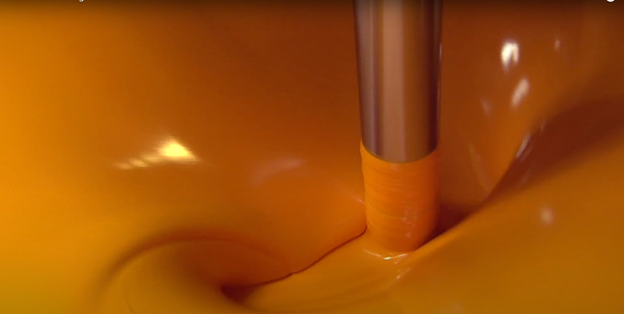3 Key Flexo Components for Successful Shrink Sleeve Printing
Shrink sleeve printing has grown in popularity over the past few decades thanks to its various product branding and protection advantages. Its full wrap capabilities and tamper-evident features have made it a popular packaging choice for products, including craft beers, cosmetics, cleaning supplies, consumer goods, and more. Zeller+Gmelin is proud to offer high quality UV and LED shrink-friendly inks for package printing. With years of experience in this sought after application, we have witnessed printers’ success in this application due to the extensive testing and control of three major print categories. In this blog we will discuss the key printing components needed to achieve perfectly shrunk package print. Additionally, we will debunk common myths and share our best practice to help you achieve successful shrink sleeve printing. Enjoy!
What is Shrink Sleeve Printing?
To begin, let’s first clarify what shrink sleeve printing is. Shrink sleeve printing is a unique and effective print process where the ink is printed on the inside of a special shrink material utilizing either the flexo or digital print process. The printed material is then seamed and subjected to heat through a heating tunnel, heat gun, or other heating method to shrink the material seamlessly to the distinct shape of the final product.
There are multiple advantages to shrink sleeve printing.
- Full Wrap Packaging. Shrink sleeves provide a full wrap application allowing a much larger print area for high quality graphics, promotional messages and product information. This makes shrink sleeves a popular choice to improve marketing and branding, differentiating the product on the shelf.
- Tamper Evident. The tight fit of a shrink sleeve can cover the entire product, including the cap or seal, providing a tamper-evident enclosure to ensure product integrity and consumer safety.
- Durability. Considering the print is on the inside and protected by the shrink film, this print application is known for its incredible durability against moisture, fading, abrasion and heavy product use, keeping your packaging attractive throughout its product lifecycle.
- Versatility. Shrink sleeves can be applied to various container shapes and sizes making it a versatile option for a wide range of products.
- Recyclability. As more eco-conscious consumers demand sustainable packaging, shrink sleeves are a way to easily remove the printed non-recyclable material without impacting the recyclability of the product container. PSLs and direct print can leave behind residue that impacts the recycling process.
Key Components to Shrink Sleeve Printing
Shrink sleeve printing differs greatly from traditional pressure sensitive label (PSL) printing. With different materials, a different application, and a finishing process, you must control three key areas for successful shrink applications.
#1. Shrink Materials
Shrink substrates are traditionally made of a single layer plastic or polyester material that is stretched and “frozen” in place. These materials are much thinner than the dual-layer paper and plastic substrates found in traditional label printing. As a result, shrink materials are more prone to web breaks and must be handled with precise tension control utilizing web tension technologies. The material must also be compatible with the inks and the press configuration. Because shrink materials are known to have low surface energy, a corona treater is often recommended to increase ink adhesion, though it is important to test the settings to ensure optimum performance.
Shrink substrates are also assigned a percentage of shrinkage and durability. Take the time to speak with your supplier and understand the shrink percentage needed for your application and apply accordingly. As the material runs through the press, keep in mind the substrate is sensitive to heat. The press may heat up, as industrial machinery often does when run at high speeds. Therefore, chill drums are an important part of the process to prevent pre-shrinking the material on press. Shrink materials require much more care and attention than traditional label stock, so careful control and maintenance of these materials are crucial to successful shrink printing.
#2. Press Configuration
For printers running shrink sleeves, you should maintain a few features on your press to precisely print and control the shrink film material. Before running the press, printers should run the material through a corona treater. The corona treater increases the surface energy of the shrink film using a high frequency electrical discharge. This improves the ink adhesion, printability, durability, and the overall quality of the print. This will also reduce ink smudging or flaking during sleeve application and product use.
Web tension and cooling are also critical components of successful printing on shrink films. As stated above, shrink films are much thinner than other print materials and are sensitive to heat within production. To prevent web breaks and control the temperature, web tension technologies and chill drums must be used to maintain the integrity of the material. Web tension control systems ensure the film maintains a constant and controlled speed at the desired tension throughout the entire print process and during the pre-print process of corona treatment. The tension control system will prevent the material from stretching/breaking and prevent wrinkles and print defects while maintaining accurate print registration and alignment. This will enhance the overall productivity of the press and the quality of the final printed product.
Chill drums, also known as chill rollers or cooling drums, play a crucial role in rapidly cooling down the printed shrink film after ink adhesion or the curing stage. This cooling is necessary to maintain the material temperature, set the ink, and stabilize the printed film for final sleeve production. It’s important to note that the design and temperature of the chill drum must be carefully controlled for optimum results. Chill drums that are too cold or inadequate will lead to print and performance defects in the shrink material. It is a common myth that MORE chill is best, but in our experience, the web temperature will depend on your curing system, press speed and other processes unique to your print environment. Don’t just put your chill rollers to maximum. Find your chill drum “sweet spot” for the best results.
Your curing system is another press component that will greatly impact the quality of your printed shrink sleeves. Considering the material’s sensitivity to heat, it is crucial to clean and maintain your UV or LED bulbs, reflectors, and press speeds to effectively cure your inks and control the shrink of the film. As your curing system ages, it will generate more heat and fewer UV rays resulting in warped materials and less reactivity from the ink. Failing to maintain or replace your UV systems or bulbs will throw money down the drain with more material waste due to shrinkage and poor product quality from poor ink adhesion. Another common myth is that LED curing systems don’t give off heat and therefore will not require a chill drum – WRONG. LED systems may not put out heat itself, however the ink will react to the LED curing process and give off heat during the chemical reaction. Whether you use LED or UV curing systems, it is still important to use web temperature controls.
Although all press components are important for proper print, finding the optimal settings for your corona treater, web tension control system, chill drums and curing system will be the key to successful shrink sleeve printing.
#3. Inks & Coatings
Inks and specific pigments have a special relationship with the curing process that can affect your shrink sleeve printing quality. Considering the effect of heat on the shrink film material, ink colors are known to absorb or reflect different levels of the UV spectrum resulting in some interesting outcomes in shrink. It’s important to note that dark colors such as blacks, blues and purples will absorb a large part of the UV spectrum, resulting in more heat input on those areas of the print, making it more prone to shrink. At the same time, light colors will reflect a large area of the UV spectrum, energizing the print around it and moving the heat to other areas of the film. Shrinkage is inevitable, but preparing your systems for the level of pre-shrink dependent on the print colors and areas will be the best way to remain proactive against material warping.
Additionally, the temperature of the web can impact the ability of the ink to cure or adhere to the film material properly. Though it’s important to keep the web cold, if the web is too cold the ink will not have the proper chemical reaction needed to adhere to the substrate. This can result in improper slip out of whites or tacky, smudgy print. An optimal press configuration is required for proper ink performance.
Before moving any further, speak with the ink specialists at Zeller+Gmelin. It is vital that we understand the final print product and application to recommend the proper ink and cure settings for print excellence. For example, if your shrink labels are put on the container prior to the filling process, they could be exposed to abrasive chemicals that impact the ink if they come between the container and shrink sleeve. Or let’s say the finishing process uses a water-based seaming solvent that separates the pigment from the ink and bleeds throughout the substrate. Opting for a chemical-resistant ink or a slip layer coating in these situations is necessary to ensure product integrity – but of course you must ask those questions to the customer to understand the entire production process and identify where and when these ink properties are needed.
Shrink Sleeve Best Practice
At Zeller+Gmelin, we always recommend a shrink performance test be conducted prior to full production. A proper test will ensure the artwork is correctly designed and distorted to shrink and seam properly, the material is at the correct shrink percentage and the ink used can withstand the chemicals exposed during production. Do not print within the folds or at the seam to avoid cracking in your final product. Alternatively, you can design the artwork where the cracking looks intentional in the design. To increase the eco-friendliness of your shrink sleeve packaging, utilize a PVC-free film made from bio-based materials along with low migration inks, compliant with all regulatory applications, from Zeller+Gmelin.
A final word of ink advice from the Z+G ink specialists, don’t lay down ink on the overlap areas – move the artwork so the overlap is free of print and you’ll save yourself a headache in the long run. These areas will undergo significant distortion during the shrinkage process. If ink is applied to the overlap areas, it will also shrink with the sleeve. As a result, the ink in these areas may become distorted, causing alignment issues, color shifts, and other print defects. The artwork or text on the shrink sleeve is carefully designed to fit the container when it is in its shrunken state. Any ink laid down on the overlap areas can disrupt this design and negatively impact the overall appearance of the package.
Zeller+Gmelin is your knowledgeable ink partner, eager and ready to help you achieve shrink sleeve printing, expertly done. We hope this blog has provided a good starting point for controlling your production process for successful shrink applications. Want to learn more? Contact our team – we are happy to discuss our UV and LED inks for shrink applications, answer any questions you have and share our knowledge on Flexo print best practices for your unique application. We are here to serve you!



